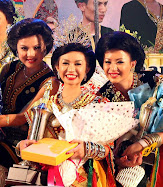

Descendants of former Sabah State native leader OKK Sedomon OKK Gunsanad on Wednesday, 17th August 2011, said they have rejected the Sabah State Government's proposal to turn their ancestral home in Bingkor, Keningau, or better known as "Rumah Besar Sedomon", into a cultural heritage of the State.
Led by Nilakrisna James, Sedomon's granddaughter, and daughter of Doreen Sodomon, Sedomon's daughter, they said it was wrong for the Government not to consult the landowners.

Nilakrisna Isnarti James, grand-daughter of OKK Sedomon
Nilakrisna said she received a letter from the Director of the Sabah Museum Department on July 22, 2011, stating the Government's interest to turn the Rumah Besar Sedomon into a cultural heritage.
She, however, said the family or rather 17 descendants of her grandfather did not agree to the proposal.
"My grandfather had wanted the house to remain a pusaka (heritage) for his descendants and it is our wish the house continues to be our communal home," she said in a press conference at TNGC Clubhousei Jalan Bundusan.
Also present at the press conference were Sedomon's four daughters, Doreen, Irene, Susie and June, who also represented their children, and his granddaughter, Nelly Sedomon, who represented both her father, Peter Sedomon, and Sedomon's eldest daughter, Catherine Sedomon.
She said there is a special condition in the land title where the Rumah Besar is located, that is the "land cannot be transferred to aliens."
The pusaka (heritage) inheritance provision states that the landowners could only effectively pass their title to a direct bloodline of Sedomon, she said.
The title, she said, was issued to Sedomon on May 10, 1940 for a period of 999 years after the completion of the house.
The OKK Sedomon's Rumah Besar or Big House is situated on 12 acres of land and was built between 1937 and 1941. It took 4 years to complete as the works were done manually using very basic tools whereby every piece of timber was cut to the required specifications.
The timbers used in the construction were from the jungle, about 40 to 50 kilometres away from the house, transported using a "Guyudan" a Dusun term for a buffalo-drawn cart.
The workers of the house were generally of Chinese origin and they were instructed by OKK Sedomon to build a house which imitated the architecture of early 18th century Malay Sultanate palaces.
The house had a dining passage in the ground floor, a gathering area for festive season or villagers gathering for Tapai drinking session. Tapai is Sabah's traditional rice wine and is stronger than beer, stout and whiskey.
In 1942, the family who lived at the house or Rumah Besar was forced to leave by the brutal Japanese military who used that house as their dwellings during World War II.
The brutal war caused great distress and loss to the family, their farms and live-stocks were completely destroyed by the marauding Japanese army.
Shoot outs between the Japanese Imperial Army and the Australian military also happened right in the Rumah Besar or Big House.
Today, bullet holes can still be seen on that house. Even a small pond was created at the side of the house, caused by bombs.
Many prominent figures, important people and distinguished guests visited the house.
They included Sir William Goode the former Governer of British North Borneo, Right Honourable Duncan Sandys, British Minister for Commonwealth Relations, Tunku Abdul Rahman Putra Al-Haj, the 1st Prime Minister of Malaysia, Tun Razak Hussein (second Prime Minister of Malaysia), Tun Datu Mustapha Datu Harun (former Chief Minister of Sabah), Tun Mohammed Fuad Stephens (former Chief Minister and Governor of Sabah), Tun Ahmad Koroh (former Governor of Sabah),
"Upon Sedomon's death (on 8th March 1966), the land was declared by the Registrar to vest upon Sedomon's 10 children and bypassed his wives, whom at that time, were considered 'alien' to the bloodline and therefore not entitled to inherit the land," Nilakrisna said.
Despite no one staying in the big house, she said family members have been using it regularly for celebrations such as weddings, Kaamatan Festival and also for funeral ceremony.
To this, Nilakrisna said the law was not created to arbitrarily bypass the terms and conditions of land titles and deprive private owners of their right to use, to have and to hold their property and homes in peace without government interference and intervention.
She said if the Government used the Cultural Heritage (Conservation) Enactment 1997 to bypass specific terms and conditions and allowed the "alien" Council under the enactment to simply bulldoze its way into private properties on the pretext that their homes looked architecturally historical, then owners in this State might as well demolish and build their homes every 10 years or design space age homes.
She said they have a right to live in their homes and all present owners should have the priority to decide how they wish to maintain, decorate, renovate and develop their own homes and land.
Moreover, she said, the Rumah Besar Sedomon is not the only old home in Sabah that survived the war and nor is it architecturally unique.
There are houses with similar design such as in Tuaran, she said.
"Since 1963 until today, neither the State Government nor the Federal Government nor any of the State leaders, past or present, has bothered to fight for the Sedomon name to have any historical relevance in the history books, the museums or anywhere else," she said.
Sedomon's name, she said, has almost been obliterated.
"He was never important enough to this country to even be accorded any State award, not even BK (Bintang Kinabalu), let alone the title 'Datuk', which many have wrongly been reported in the media," she said.
The booklet "OKK Sedomon Bin OKK Gunsanad and His Rumah Besar" she co-wrote with Sedomon's ninth daughter, in June 1997, is the only one dedicated by way of a biography. There are only 5,000 copies in circulation.
Therefore, the sudden interest in the Rumah Besar and the lucrative 12 acres in Bingkor clearly has nothing to do with Sedomon's incredible leadership or the ordinary architecture, and any excuse by the Council to that effect would just be an act of hypocrisy, she said.
She said in the next 928 years, the land property shall be vested in Sedomon's bloodline and not be vested in or controlled by or monitored by alien persons, alien companies, alien councils or alien committees or anything alien from anywhere.
It is unconscionable that an Act passed in 1997 should undo the noble intentions of the North Borneo Government under the British for Sedomon, who was awarded the Member of the Most Excellent Order of the British Empire, MBE by Queen Elizabeth II for his services to the British Empire.
"If the people in this country choose to ignore his illustrious life, I am sure Sedomon would not be bothered.
"But he would have vomited blood if he knew that his direct descendants will be in any way challenged or limited in the way they choose to live in his house or his land by the decision of aliens in an alien Council appointed by the State Government," she said.
To this, she said the State Government should respect and prioritise the decisions and rights of private landowners.
There are many hundred-year-old houses in Britain and Australia and the governments there, she said, do not interfere with private ownership that makes private investors confident that buying an ancient home is a good investment.
The Government should look into how Britain does it with the National Trust, which is not run by the government of Britain.
She also expressed the family's apology to the Prime Minister and his family for a report that quoted her uncle, Justine Sedomon, which has not been authorised by any other members of the Sedomon family.
The opinions and statements made in the report, she said, belong exclusively to Justine Sedomon and do not reflect the family's views.
The late OKK Sedomon Bin OKK Gunsanad along with his younger brother GS Sundang (former Deputy Minister of Sabah) were two prominent native leaders in Sabah before Sabah gained Independence from the British North Borneo on 31st August 1963 and subsequently formed Malaysia together with Sarawak and Singapore on 16th September 1963.
OKK Sedomon opposed the Malaysia's federation proposal on the ground that his people were not ready for such a political arrangement. He instead preferred self-government and independence to come gradually for Sabah.
Has Sedomon's far sighted wish came true, Sabah would have been an independent nation today, just like Singapore and Brunei who prospers more than Sabah despite much less in size. Singapore as we know does not have rich natural resources and minerals as enjoyed by Sabah such as Oil and Gas, Palm Oil and world class tourism destinations, and yet Singapore is more prosperous in terms of GDP than Sabah.
When the Malaysia federation proposal was presented, OKK Sedomon felt that the native people of North Borneo were politically too immature to participate meaningfully in the new federation. He through Pasok Momogun urged that the native people should be educated and the territory be developed. Only after all these had been done, Sabah would be in a better position to make a decision on the proposed Malaysia federation.
OKK Sedomon was born in 1894 and died in 1966 at the age of 72 years old.

During his lifetime, OKK Sedomon was noted for his achievement in the British North Borneo and awarded the Member of the Most Excellent Order of the British Empire, MBE by Her Majesty Queen Elizabeth II on 9th June 1961.
He took over his father, OKK Gunsanad Kina as the District Chief in 1936 and assumed this role until his death in 1966.
Sedomon was also the Native Chief. Any disputes among the villagers in the remote place called Keningau, were brought to him to be settled amicably, according to the native customary laws.
OKK Sedomon active political career began in 1962 under UPKO or United National Pasok Momogun Organisation, led by himself and his younger brother, GS Sundang, which represented the native people of Sabah or rather known as North Borneo at that material time.
Pasok Momogun controlled and gained majority support of the indigenous people in the inland districts of Sabah whereas another party known as UNKO (United National Kadazan Organisation), formed in 1961 by Donald Stephens, later known as Tun Mohd Fuad Stephens, commanded the support of those on the coastal areas of North Borneo.
Misunderstandings and differences in opinions between UNKO and Pasok Momogun possibly created the beginnings of a politically terminological division between the Natives of North Borneo.
Donald Stephens waged an aggresive campaign to replace the term "Dusun" by "Kadazan" adn this was strongly opposed by GS Sundang who suggested that it was not appropriate to homogenise all Natives in North Borneo as "Kadazan".
OKK Sedomon is fondly remembered by all who knew him as a great man with few words. Throughout his life, he dedicated his life for the people, his people, the Natives of North Borneo, later known as Sabah.
OKK Sedomon who had 4 wives, died suddenly and mysteriously from unknown causes on 8th March 1966 after returning from a dinner party.
His legacy lives on.
Rest in Peace Sir...
Source : Daily Express 18th August 2011 and O.K.K SEDOMON BIN O.K.K GUNSANAD AND HIS RUMAH BESAR Booklet by June Sedomon and Nilakrisna Isnarti James.

































No comments:
Post a Comment